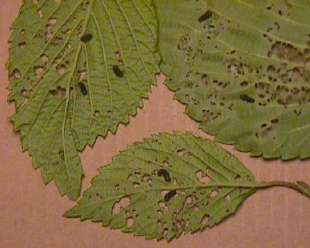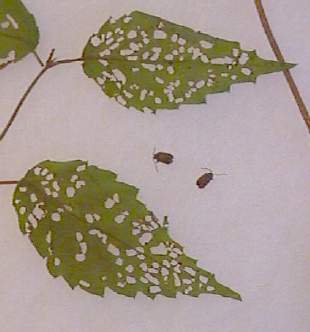

Noticing damage to Arrowwood and Cranberrybush Viburnum plants? The Viburnum
Leaf beetle is a new insect to our area. A Cornell entomologist, Rick Hobeke, has been following
the activity of this European insect since it first became established in Canada in the late 1970's. It
was first identified in New York in 1996, and we confirmed the first case in Monroe County in
1997.

Viburnum Leaf beetle description and life cycle:
The larvae appear in May, are pale greenish colored, about 1/4 inch long and covered with
dots. These larvae are voracious eaters, and will skeletonize the foliage of its preferred hosts. In
mid to late June they will fall to the ground, where they will pupate. Then in mid- to Late July the
adults will appear. The adult beetles are slightly smaller than the juveniles, dark golden brown in
color, are also big eaters, and can almost cause as much damage as the juveniles.
Larvae and affected foliage

The adults may
be seen until the first frost. In late summer and early fall, the adults will lay their eggs at the
terminals of Viburnum branches. They pack the eggs with a mixture of chewed plant material and
their own black excrement. The eggs remain dormant on the branch tips until the following May,
when the larvae will emerge and begin feeding on the newly emerged foliage. There is only one
generation per year.
Adult beetle and affected foliage
Control:
In late winter or early spring, examine the small twigs for rows of the dark spots which are the overwintering egg sites. Prune out and destroy affected wood before egg hatch occurs in May. Once leaves have begun to expand, examine both the upper and lower leaf surface for the feeding larvae. If chemical controls are to be used, best control will probably be achieved if applied while larvae are young.
Horticultural oil may be used to control the larvae. Larvae and adults should be controlled by products such as insecticidal soap and chlorpyrifos. Be sure to follow all product label recommendations. For effective control, apply when the insects are actively feeding. Detection may be difficult, as these insects tend to feed on the lower leaf surface. Hitting affected branches and having a collection cloth or paper below to catch the dislodged insects can help determine if the insects are present.
Consider planting resistant viburnum species.
|
Preferred Hosts (moderate to severe damage) |
Viburnum opulus, European highbush cranberry and its selections V. dentatum, arrowwood viburnum V. trilobum, American highbush cranberry viburnum |
|
Secondary Host (slight injury) |
V. lantana, wayfaringtree viburnum V. rafinesquianum, refinesque viburnum V. acerifolium, mapleleaf viburnum V. lentago, nannyberry viburnum |